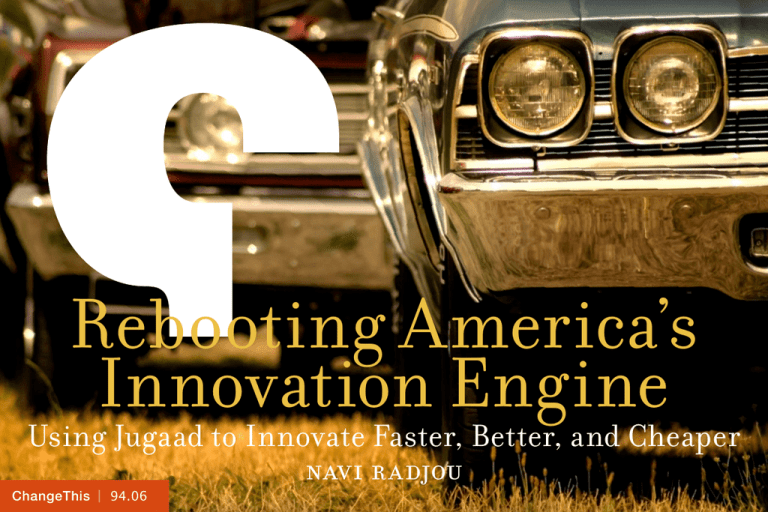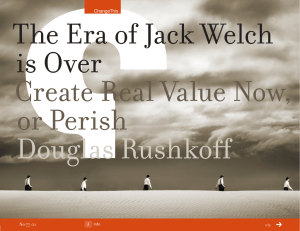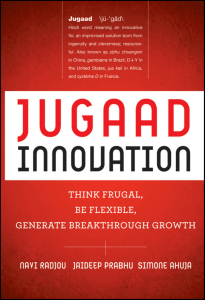Rebooting America’s Innovation Engine Using Jugaad to Innovate Faster, Better, and Cheaper
advertisement

Rebooting America’s Innovation Engine Using Jugaad to Innovate Faster, Better, and Cheaper navi radjou ChangeThis | 94.06 The US innovation engine is stuck in low gear. According to Booz & Company, in 2010 alone, the world’s largest corporations—many of which are American firms—spent nearly $550,000,000,000 (yep, that’s more than half a trillion dollars) in R&D and yet still struggle to churn out innovative products. Case in point: Big Pharma spent $45 billion in R&D in 2009, but the number of new drugs they launch has dropped by 44 percent since 1997. This is not reassuring for Big Pharma since $139 billion worth of drugs are set to go off patent between 2011 and 2016. You can see the writing on the wall. The motto “innovate or die” held true for American firms in the 20th century. In the 21st century, “innovate faster, better, and cheaper—or die” will be your new mantra. Indeed, in today’s hypercompetitive, über-connected, and globally integrated economy, you need to crank out new products faster than you can spell “R&D,” or else your customers will switch their allegiance to more agile rivals. Plus, your products need to deliver more value to customers—value no longer being defined by the bells and whistles in your product, but by the experience customers get from using your product. Finally, given the rapidly-shrinking purchasing power of the American middle class, your products have to be affordable to meet the frugal needs of thrifty US buyers. ChangeThis | 94.01 In sum, you need to innovate faster, better, and cheaper. Sadly, Corporate America is just not equipped to do that. Why not? For three simple reasons: 1) US firms’ R&D system is way too costly to maintain (as mentioned earlier) at a time when both financial and natural resources are getting scarce; 2) US firms rely on “structured” innovation processes like Six Sigma that can’t deliver the agility and speed companies need in a fast-paced and volatile world; 3) Many American firms continue to believe that “knowledge is power”—hence they do innovation in secret R&D labs rather than opening up the innovation process and harnessing the creativity of all their employees, customers, and partners. Due to these limiting factors, companies across industries—ranging from pharmaceuticals and automotive to consumer goods, electronics, and retail—have seen their innovation performance steadily decline over the last decade. But there is hope… if US firms are willing to trade profligacy, rigidity, and elitism—which characterize their current innovation model—for frugality, flexibility, and inclusivity. To make this shift, however, US firms must embrace a new mindset—a frugal and flexible mindset that sees opportunity in adversity and enables you to do more with less. This is the mindset of MacGyver, the secret agent in the popular TV series of the late 1980s who carries no gun and relies purely on his ingenuity to fix complex problems using the limited resources he has at ChangeThis | 94.01 hand—usually duct tape and a Swiss Army knife. Corporate America needs more MacGyvers to regain its “innovation mojo” and achieve faster results in today’s unpredictable environment. But where can American CEOs find these MacGyvers? They can start recruiting them among the Millennials who are swelling the ranks of the US workforce. “ The motto “innovate or die” held true for American firms in the 20th century. In the 21st century, “innovate faster, better, and cheaper—or die” will be your new mantra. Yuri Malina is one such ingenious and resourceful Millennial. The 21-year-old Malina truly embodies the frugal and flexible “do-it-yourself” (DIY) mindset of Gen Y. While studying at Northwestern University, Malina co-founded Design for America (DFA). DFA is a grassroots student organization with studios across many US universities led by “creative activists” striving to create innovative solutions to pressing socio-economic problems facing local communities across America. DFA members lead projects that tackle big challenges in energy, education, healthcare, and transportation. Malina and other DFA members are using limited resources and agile processes to innovate faster, better, and cheaper—in a unique way that no corporate R&D lab can match. ChangeThis | 94.01 For instance, Malina and his teammates set out to reduce the infection rate in hospitals, a big issue afflicting US healthcare. According to the CDC, nearly 1.7 million hospital-associated infections cause or contribute to nearly 100,000 deaths each year, costing the U.S. healthcare system between $4.5 and $11 billion annually. Most infections occur because physicians and nurses don’t wash their hands regularly. Eager to improve hand hygiene, hospitals have deployed hand-sanitization stations throughout their facilities and some even RFID-tagged their employees to monitor their visit to hand-washing stations. But none of these expensive and complicated solutions have worked—while the infection rate continues to rise. Enter Malina and his MacGyver team. Rather than inventing a blue-sky solution, Malina’s team first attempted to identify the needs of the “customers”—i.e., the doctors and nurses. They observed that these clinicians, who were always “on the move,” found it cumbersome to regularly go to a hand sanitation station that wasn’t always close by. Watching these doctors and nurses in action, Malina’s team had a Eureka moment: “What if we can create a non-intrusive solution that adapts to the work habits of doctors and nurses—rather than the other way around?” The outcome was SwipeSense, a portable “roll-on” hand-sanitizer that hospital employees can use to clean their hands on the go. SwipeSense is a simple solution—but it is far more effective than existing hand sanitation solutions for several reasons. First, it doesn’t require clinicians to alter ChangeThis | 94.01 their work habits; rather, it taps into their natural instinct for hand wiping. Second, it is easy to use and carry as doctors and nurses can clip it to their uniforms. Third, it is very affordable: the SwipeSense devices, currently under development, will cost less than $2.00 per unit when produced in large volume. SwipeSense promises to reduce the infection rate in hospitals faster, better, and cheaper than more expensive alternatives. Unlike large medical device makers, Yuri’s team didn’t require big R&D investments or sophisticated factories to create SwipeSense. Instead, they used the tools they had on hand (such as a 3D printer) and a healthy dose of “can-do” attitude to produce a workable solution to a tortuous problem. They are the 21st century MacGyvers—resourceful Millennials leading an innovation revolution across the U.S. Malina is not an exception. While US firms remain straightjacketed in an expensive “top-down” innovation model—which is resource-intensive, too rigid, and super-elitist—a “bottom-up” and frugal approach to innovation is gaining traction in grassroots America. In our book, Jugaad Innovation: Think Frugal, Be Flexible, Generate Breakthrough Growth, my coauthors and I chronicle a huge innovation movement unfolding across America led by socially-conscious organizations such as Design for America run by Millennials, academic institutions such as Stanford University spearheading programs like Entrepreneurial Design for Extreme Affordability, and progressive government bodies such as the White House Office of Social Innovation and Civic Participation. ChangeThis | 94.01 These grassroots US innovators are coming up with affordable and sustainable solutions to address America’s energy, education, and healthcare issues. Their modus operandi? Jugaad—a Hindi word meaning an innovative fix or an improvised solution born from ingenuity and resourcefulness. Jugaad is a frugal and flexible approach to innovation already practiced by millions of entrepreneurs in emerging markets such as India, China, Africa, and Brazil who are able to improvise simple but effective solutions to pressing socio-economic problems using limited resources. Jugaad is nothing but “Yankee ingenuity”— which has waned from Corporate America that opted for structured business practices like Six Sigma that have stifled employees’ free-flowing creativity. MacGyver is the quintessential jugaad innovator. He truly embodies the resilient and resourceful spirit of jugaad. “ While US firms remain straightjacketed in an expensive “top-down” innovation model—which is resource-intensive, too rigid, and super-elitist—a “bottom-up” and frugal approach to innovation is gaining traction in grassroots America. ChangeThis | 94.01 With the US economy facing growing complexity and resource scarcity, it’s high time US corporate leaders ignite the jugaad spirit in their organization in order to innovate faster, better, and cheaper. Unless they do so, they will lose out to forward-thinking firms that have successfully adopted the jugaad innovation principles to turbocharge their growth. To win in today’s fastpaced, hypercompetitive environment, you must embrace without delay the following six jugaad innovation principles: 1 » Seek opportunity in adversity: US companies are entering a period of sustained turbulence characterized by a worsening macro-economic situation, a barrage of new regulations, tectonic shifts in demographics, depleting natural resources, and the social computing revolution. When confronted with such extreme adversity, many companies tend to act like a deer caught in the headlights. But entrepreneurial organizations with a jugaad mindset are more resilient: they systematically turn adversity into an opportunity for innovation and growth. Take, for instance, 3M. In the mid-2000s, the legendary industrial firm was facing increasing competition from agile rivals across many of its product segments, which are becoming obsolete or outright commoditized. Yet the company couldn’t respond quickly to the major shifts in the marketplace as it was straightjacketed in Six Sigma processes that were arguably stifling its legendary jugaad spirit (which, in the past, had helped create blockbuster products like the Post-it Note). ChangeThis | 94.01 Sensing an opportunity in adversity, George Buckley, who became 3M’s CEO in 2005, rolled back the Six Sigma initiatives and revived 3M’s risk-tolerant jugaad culture. By allowing for “bottom up” innovation to flourish again across its organization, 3M unleashed the creativity of all its employees and tapped into their resilience to combat the economic recession. In 2010, 3M bucked the recession by posting a healthy $26.7 billion in revenue and a record profit of $5.9 billion. It is now generating nearly a third of its revenues from new products—and, in 2011, was ranked by Booz & Company as the world’s 3rd most innovative firm (right after Apple and Google.) 2 » Do more with less: For most US companies bigger is still better—which explains why they are wedded to the “more for more” strategy by pumping more dollars into R&D hoping those hefty investments will miraculously yield more innovation—but that just is not happening. In the dawning Age of Scarcity, however, US companies can no longer afford to be spendthrift. Not only do they need to learn to do more with fewer resources, they also need to make their offerings more affordable to cost-conscious American consumers. Without delay, US firms need to embrace the frugal jugaad mindset to deliver more value at less cost for more consumers. Two companies—PepsiCo and Renault-Nissan—are doing exactly that. PepsiCo, for instance, is proactively reinventing its business model as an affordable and sustainable provider of healthy and nutritious foods and beverages in response to the growing consumer demand for healthy food. ChangeThis | 94.01 Indra Nooyi, PepsiCo’s CEO, intends to grow the company’s “good-for-you” portfolio of products to $30 billion in net revenue by 2020. She is also encouraging a “bottom up” jugaad approach to dealing with scarcity of natural resources. In recent years, several employee-driven grassroots initiatives worldwide have produced breakthrough solutions for reducing water and energy consumption all along PepsiCo’s supply chain. Similarly, Carlos Ghosn, CEO of Renault-Nissan, is incentivizing his Western engineers to practice what he calls “frugal engineering”—i.e., the ability to develop and produce cars with a simplified design that are nonetheless affordable and robust. After producing the Logan—a highly successful sedan that retails for about $10,000— Renault-Nissan’s engineers are now pushing the boundaries of frugality even further: they are currently designing “ultra-low-cost” cars that could sell for less than $5,000 and thus meet the needs of cost-conscious buyers worldwide. 3 » Think and act flexibly: In today’s business environment that operates at the speed of light, US firms need to be nimble-minded and nimble-footed. They can’t afford to be complacent and slow in responding to rapid changes. To succeed in today’s fast-paced economy, companies need more than flexible processes: they need an agile mindset. Just thinking outside the box won’t cut it: you need to create whole new boxes. By embracing the non-linear thinking of jugaad innovators, US firms will be able to improvise breakthrough solutions and turn conventional wisdom on its head and help shape entire new markets and industries. ChangeThis | 94.01 Google is one company that excels at improvising creative solutions. The search giant is organized as a loosely-connected network of small and nimble teams that can swiftly react to changing market needs—by cranking out new products in rapid-fire mode. According to its executive chairman Eric Schmidt, Google doesn’t use multi-year strategic plans, but rather relies on weekly plans. The New York Times Company (NYTC) is another company demonstrating flexible thinking. With the Internet slowly killing the print media and stealing away advertising revenues, NYTC has proactively embraced social media and mobile technologies, rather than being disrupted by them. In the process, NYTC is radically reinventing its business model from a newspaper into a provider of digital content across multiple platforms. 4 » Keep it simple: US firms are typically engaged in an “arms race” to out-innovate each other by cramming more technology and features into their products. But customers are put off by these over-engineered products that they find too complex to use. It’s high time US firms embrace simplicity as a key tenet of their innovation projects—just as jugaad entrepreneurs do—and focus on creating “good enough” solutions that get the job done rather than seeking technology sophistication or perfection. By enshrining simplicity in all their solutions, US firms can ensure these solutions are accessible and easy-to-use by a large number of users. For instance, in recent years, the electronics giant Philips has made great strides in simplifying its products by “humanizing technology” (as John Maeda, president of the Rhode Island School of Design, puts it). ChangeThis | 94.01 By systematically weeding out complexity from all its products right from the design phase, Philips has produced dozens of award-winning products that stand out for their simple and elegant design as well as their superlative ease of use. 5 » Include the margin: Median incomes in the US have stagnated for the past thirty years. The bottom 60 percent of US households suffered from an income loss in 2010. As a result, the 5 percent of Americans earning the highest incomes currently contribute to 37 percent of all US consumption. US firms need to pay attention to the “marginal segments”—made up of low-income consumers—which are poised to grow in size as the American middle class gradually loses its purchasing power. US firms need to emulate jugaad entrepreneurs who devise radically affordable solutions to address the needs of underserved customers. Procter & Gamble, for example, is drastically overhauling its business model to make it more “inclusive.” The consumer product giant is introducing a whole gamut of low-cost products targeted at a growing number of middle-class consumers who can no longer afford its premium products. Similarly, Wal-Mart has opened 1,500 Walmart Money Centers across the US to serve the basic financial needs of low-income consumers (there are 60 million Americans today who are either unbanked or under-banked.) Companies such as Procter & Gamble and Wal-Mart now recognize that you can make big margins by…including the margin. ChangeThis | 94.01 6 » Follow your heart: The heart is the seat of passion, intuition, and empathy. Yet, most US companies seek refuge in data—and shun intuition. Marketing execs, for instance, depend on focus groups to decide what products to make—rather than trusting their gut and engaging customers in a genuine and empathetic relationship. Worse, US firms heavily rely on traditional financial incentives such as bonuses to motivate their employees rather than empowering them to pursue their passion—an oversight that leads to severe employee disengagement. But “heartpowered” organizations with a jugaad culture encourage employees to follow their intuition— and use their empathy and passion to discover meaningful ways to generate value for themselves, their company, and the society at large. “ The heart is the seat of passion, intuition, and empathy. Yet, most US companies seek refuge in data—and shun intuition. At Apple, for example, employees continue to follow the example set by Steve Jobs. Jobs was a quintessential jugaad innovator who always heeded his intuition and disrupted one industry after another by launching breakthrough products—the iPod, iPhone, and iPad—despite the initial skepticism of consumers, investors, and the media. Likewise, frog, a global design and innovation consultancy, has launched a bold project called Centers of Passion that allows its creative workers ChangeThis | 94.01 worldwide to start or join projects in which they find a deep sense of meaning and purpose— that is far more rewarding than intellectually or even emotionally-rewarding assignments. As US firms strive for fast results and breakthrough growth, they have much to gain from adopting and practicing these six principles of jugaad—seek opportunity in adversity, do more with less, think and act flexibly, keep it simple, include the margin, and follow the heart. These principles—if implemented properly—can help Corporate America innovate faster, better, and cheaper. During the 20th century, the US model of innovation has been akin to an orchestra: top-down, rigid, and run by upper-level employees. This model is effective in a stable world of abundant resources. But to succeed in the complex and volatile business environment of the 21st century, US companies need an alternative approach, one that is like a jazz band: bottom-up, improvisational, fluid, and collaborative while working within a framework of deep knowledge. Jugaad represents that alternative. ChangeThis | 94.01 Info Buy the Book | Get more details or buy a copy of Jugaad Innovation. About the Author | Navi Radjou is an innovation and leadership strategist based in Silicon Valley, a Fellow at Judge Business School, University of Cambridge, and a World Economic Forum faculty member. Most recently, Navi served as the Executive Director of the Centre for India & Global Business at Cambridge Judge Business School. Previously, Navi was a longtime VP/analyst at Forrester Research in Boston and San Francisco who worked with senior executives worldwide on breakthrough growth strategies. Navi has consulted with leading organizations— including Ernst & Young, GM, Hitachi, IBM, Marks & Spencer, Microsoft, Procter & Gamble, SAP, Sprint, and TCS. ➔ Send this | Pass along a copy of this manifesto to others. ➔ Subscribe | Sign up for e-news to learn when our latest manifestos are available. This document was created on May 9, 2012 and is based on the best information available at that time. The copyright of this work belongs to the author, who is solely responsible for the content. This work is licensed under the Creative Commons Attribution-NonCommercial-NoDerivs License. To view a copy of this license, visit Creative Commons or send a letter to Creative Commons, 559 Nathan Abbott Way, Stanford, California 94305, USA. Cover image from Veer. You are given the unlimited right to print this manifesto and to distribute it electronically (via email, your website, or any other means). You can print out pages and put them in your favorite coffee shop’s windows or your doctor’s waiting room. You can transcribe the author’s words onto the sidewalk, or you can hand out copies to everyone you meet. You may not alter this manifesto in any way, though, and you may not charge for it. ChangeThis | 94.01 About ChangeThis ChangeThis is a vehicle, not a publisher. We make it easy for big ideas to spread. While the authors we work with are responsible for their own work, they don’t necessarily agree with everything available in ChangeThis format. But you knew that already. ChangeThis is supported by the love and tender care of 800-CEO-READ. Visit us at 800-CEO-READ or at our daily blog. Explore your knowledge further with KnowledgeBlocks, a new project from 800-CEO-READ that lets you turn what you know into knowledge you can use. ChangeThis | 94.01








